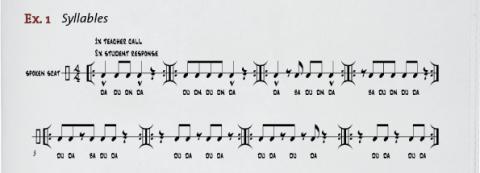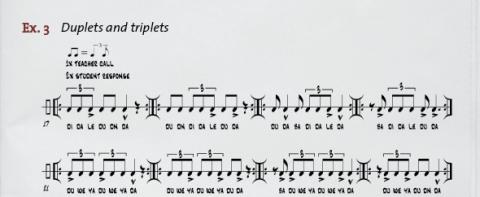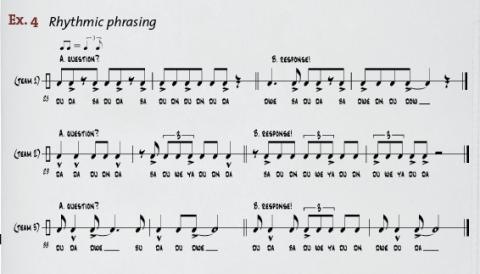The Woodshed: Scatting Without Fear

Bob Stoloff is the assistant chair of Berklee’s Voice Department and an in-demand clinician and adjudicator. He penned the books Scat! Vocal Improvisation Techniques and Blues Scatitudes and Body Beats. He is completing a new book, Vocal Improvisation: The Berklee Method.
In my 35 years of teaching vocal improvisation, I've never encountered a student who, with some basic training, was truly incapable of scat singing. When faced with the prospect of using their voice to improvise, many students express unfounded feelings of fear and intimidation. Overcoming this psychological barrier adds another dimension of challenge to teaching improvisation. With that in mind, here are some simple, non-intimidating vocal exercises that I use to teach novice improvisers.
The Original Musical Instrument
One of the best ways to learn how to sing scat is to think of the voice as a musical instrument; after all, it was indeed the first instrument. The voice has special qualities. I encourage students to "play" their voices by simulating the motions used to navigate a brass, woodwind, string, or percussion instrument. Having no mouthpiece, reed, bow, or mallets, vocalists need to rely on the lips and tongue to articulate sound. With no keys, valves, or strings to press, the larynx has to be trained to change pitch accurately on command. Learning how to use different body resonance chambers (the head, nose, throat, and chest) can change tone quality and timbre. The mouth is an embouchure that can shape, color, and affect the sound in a variety of ways. What scares some folks is that the whole body is your instrument - very exposed sans convenient brass or wooden camouflage for cover. The best part of using your voice as a musical instrument is that you don't need to practice everything in 12 keys! Vocal articulation is the foundation of good scat singing, so let's begin with a simple and non-intimidating rhythmic approach.
Syllables
Although I encourage students ultimately to make up their own syllables, I work with many students for whom English is a second language who have urged me to offer a basic vocabulary of clinically tested and officially approved scat syllables. After listening to Jon Hendricks, Louis Armstrong, and Ella Fitzgerald for many years and drawing on my experience as a trumpet player, it was easy to come up with a "Scat As a Third Language" syllable primer.
The first music example is in a casual call-and-response style that uses spoken, nonpitched rhythmic figures (see page 29). In the first meeting of most language classes, basic vocabulary is taught by ear. Example 1 introduces vowel sounds ah and oo and the short quarter note and syllable dn that is never accented and functions as a rhythmic ghost note. Note that in one-bar phrases, there is no need for more than two vowel sounds. But I highly recommend using three or more in longer phrases for additional color and symmetry. The consonants B and D are standard articulations for attacking a note. When calling out these rhythmic phrases, teachers should also consider employing some vocal nuance to avoid sounding mechanical. Because most folks associate scat singing with a swing eighth-note feel, I have chosen to use a jazz swing feel for the purpose of exemplification.
Accents
Since spoken scat is indefinitely pitched, it's important to use vocal inflection to suggest melodic contour, punctuate rhythms with indicated markings, and, most important, to articulate accents. Example 2 employs accented notes both preceding and following rests. When notating scat, these rest configurations don't necessarily have to be written; the note can be "naturally" accented by simply changing the vowel. Additionally, as a general rule, the first note of any tied notes should be accented because it often indicates upbeat anticipation.
Duplets and Triplets
Novice scat solos often reveal a weakness in rhythmic vocabulary. It's safer, but unfortunately there's a significant damper on solos that use mostly quarter and duple rhythms. When used tastefully and with well-placed accents, triplets will enhance phrases significantly, which is shown in example 3. Notice that eighth-note triplets rarely accent the middle note. Further, the vowel ee has been added for additional color and balance.
Rhythmic Phrasing
Once students are comfortable with the concept of nonpitched spoken scat, it is time to introduce the idea of "conversational scat." I initiate this exercise by proposing a round-robin, question-and-answer game in which students sit in a semicircle in teams of two, where teams are designated A and B. When there is an odd number of participants, during the first round the A team asks the questions and the B team responds with answers. It's a vocal improvisation Q&A session of sorts. If there is an even number of class members, the teacher (or facilitator) should enter in alternate rounds to reverse the roles for questioning and answering. In this exercise, we increase the phrase length to two bars for each singer. Because this interaction opens the door to solo communication, eye contact is essential. This is all improvised, of course, but example 4 demonstrates what a question-and-answer scat dialogue round might sound like.
The 12-Bar Solo
The ultimate goal of all improvisers is to make a definitive personal statement or solo that can vary in length. Novice scat singers often don't realize that, like any narrative, a solo should tell a story with a beginning, middle, and end. Example 5 is a 12-bar solo divided into three distinct four-bar phrases. The blues form is a perfect vehicle to practice this structure, because it can be divided into three four-bar phrases or a mix of two- and four-bar phrases. It's also a great segue to adding pitches for those with little or no musical training.
Once entry-level scat singers become confident with syllables and rhythmic phrasing, pitch is gradually introduced using prescribed melodic patterns, beginning with major and pentatonic scales. With continued call-and-response exercises, conversational format, and carefully sequenced sing-along chord progressions, vocal improvisation fledglings will rapidly feel brave enough to invent their own motifs and "fly the coop," so to speak, able to improvise without fear!

Ex. 1
Bob Stoloff

Ex. 2
Bob Stoloff

Ex. 3
Bob Stoloff

Ex. 4
Bob Stoloff

Ex. 5
Bob Stoloff




